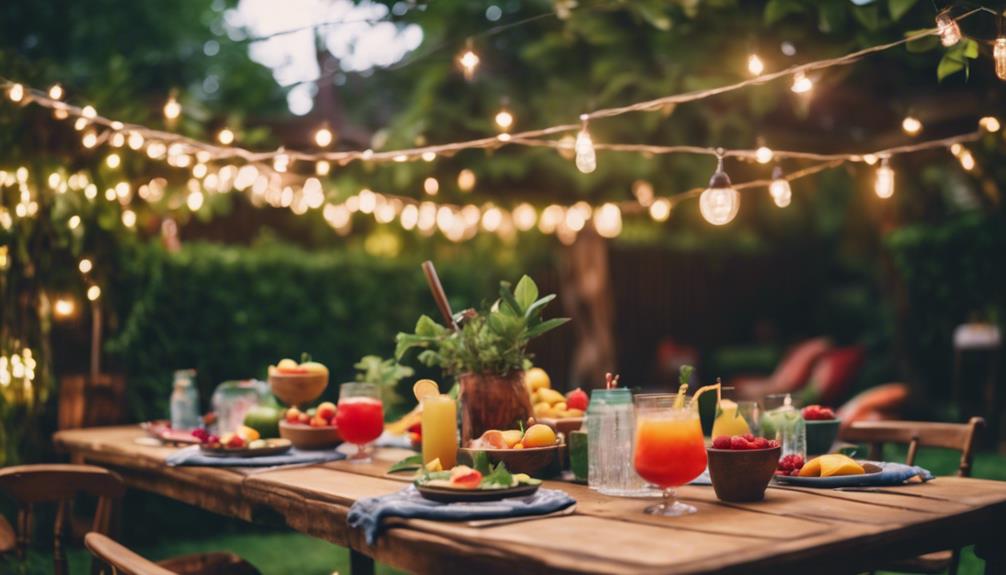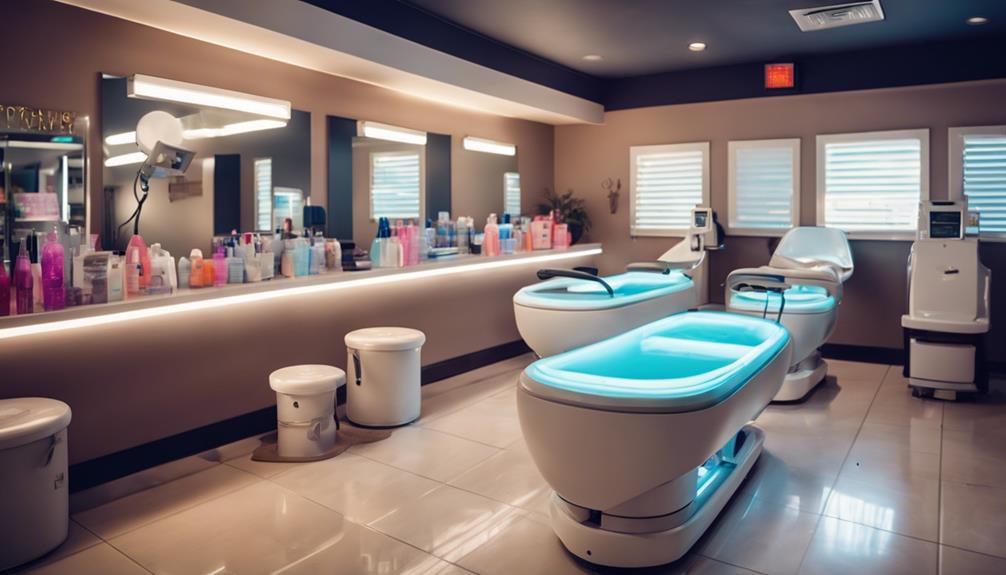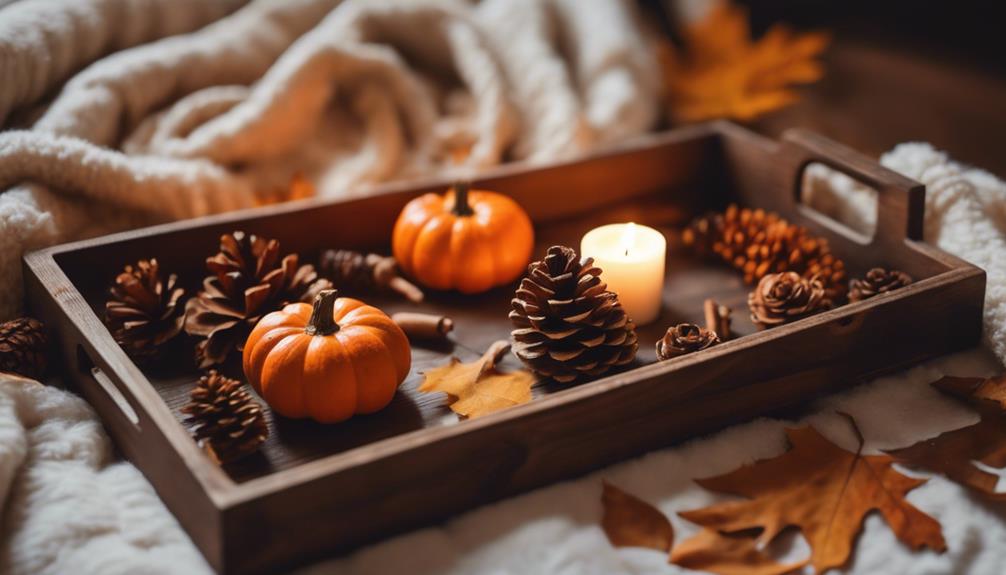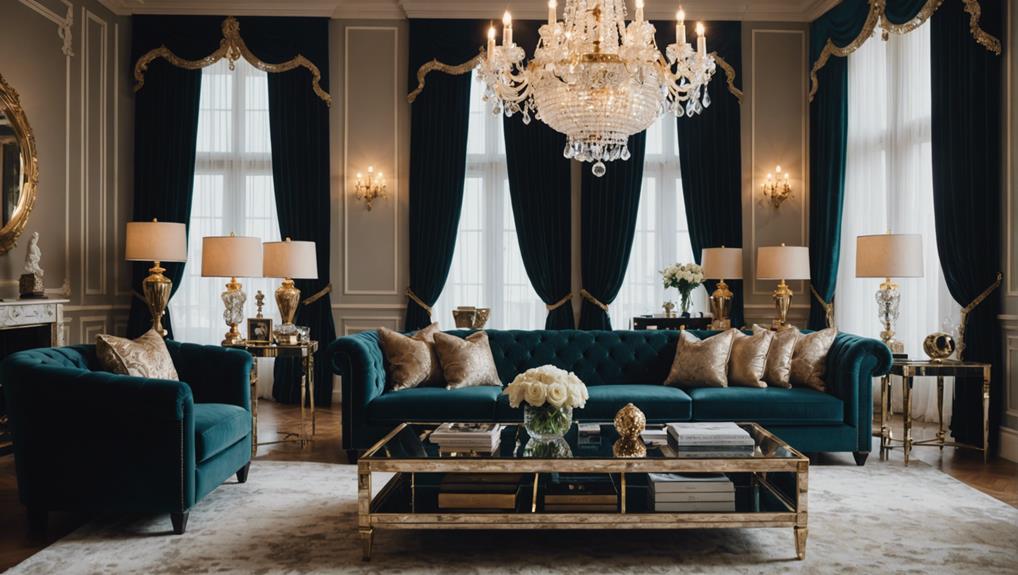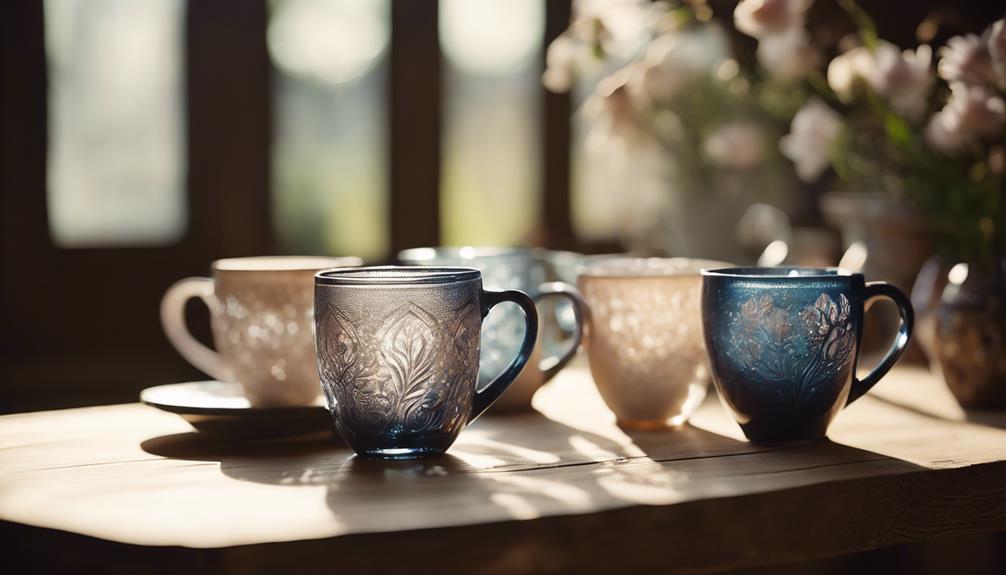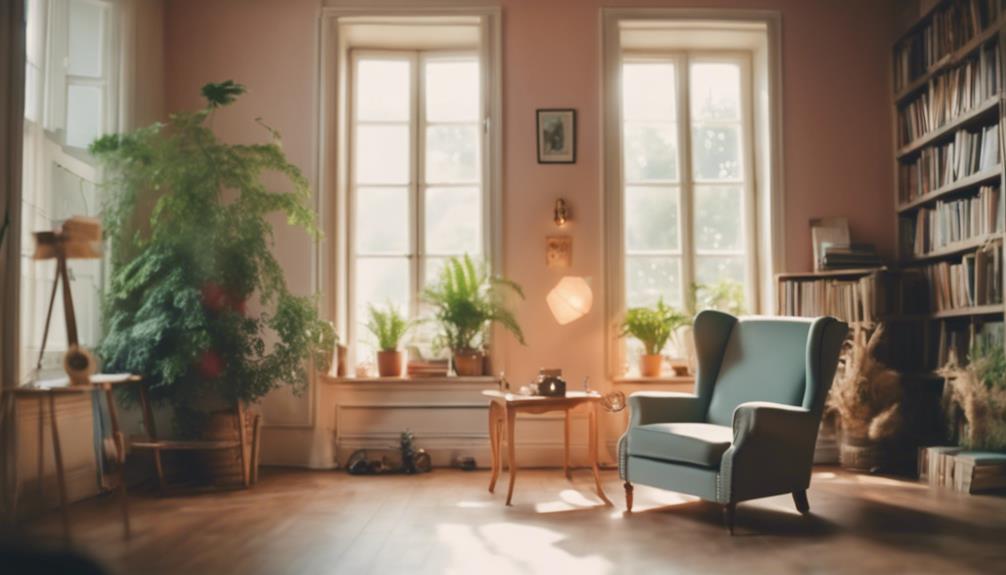To host the perfect late summer party, focus on a few key elements. Start with a simple menu—choose dishes that can be prepared ahead and include something warm, like grilled veggies. Create an inviting atmosphere with comfortable seating and ambient lighting, like string lights or candles. Engage your guests with fun yard games or a DIY cocktail station for added interaction. Don't forget self-serve snack stations and a few small decorative touches to elevate the ambiance. By keeping it relaxed and enjoyable, you'll guarantee everyone has a great time, and there's plenty more to explore for an unforgettable event.
Key Takeaways
- Plan a manageable menu with three to four appetizers, one main dish, and one dessert, focusing on make-ahead options.
- Create an inviting atmosphere with comfortable seating, ambient lighting, and engaging music to enhance guest interaction.
- Set up interactive yard games and DIY cocktail stations to encourage mingling and a fun, relaxed vibe.
- Utilize visually appealing food presentation techniques, incorporating contrasting colors and garnishes for an elegant touch.
Menu Planning Essentials
When planning your late summer party menu, focus on dishes you can prepare ahead of time to reduce stress on the big day. Menu planning fundamentals include selecting items that are good at room temperature or can be chilled, such as vibrant salads and seafood platters. These dishes not only save you time but also keep your guests satisfied while they mingle.
Aim for a balanced dinner party menu that showcases a variety of flavors and textures. Incorporate at least one warm dish, like a hearty pasta or grilled vegetables, to add comfort to your spread. It's important to accommodate dietary restrictions, so consider including vegetarian and gluten-free options.
To streamline your preparation, limit the number of different dishes. A good rule of thumb is to choose three to four appetizers, one main dish, and one dessert. This keeps your menu manageable while still offering a delightful array of choices.
For inspiration, check platforms like Pinterest to gather ideas and visually organize your menu. With these menu planning fundamentals in mind, you'll create a stress-free and enjoyable experience for both you and your guests.
Creating an Inviting Atmosphere
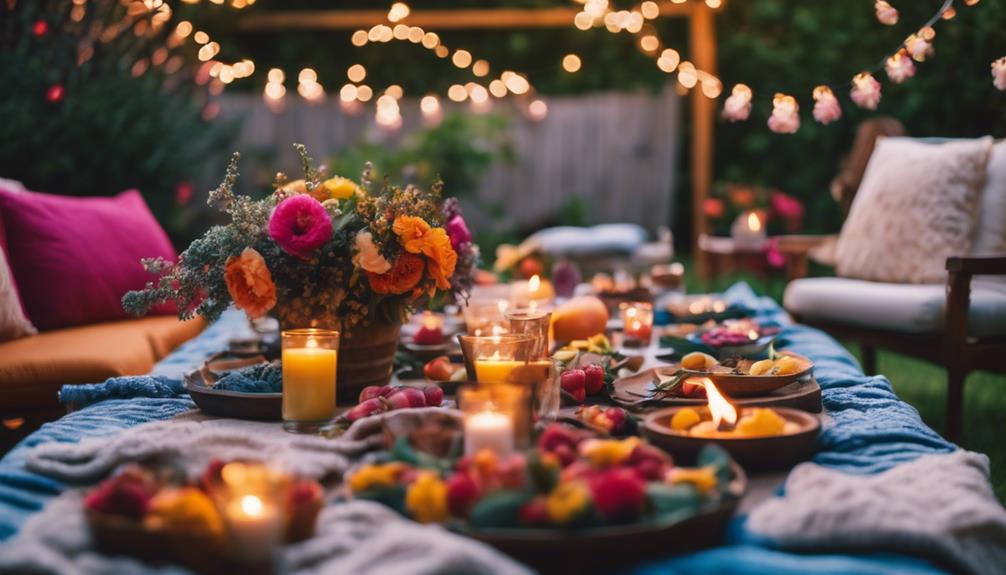
After you've planned a delicious menu, focus on creating an inviting atmosphere that encourages your guests to unwind and enjoy the celebration. You can transform your outdoor space into a cozy retreat with a few thoughtful touches.
| Element | Description |
|---|---|
| Outdoor Rugs & Cushions | Use colorful rugs and plush cushions to enhance comfort and make your guests feel at home. |
| Ambient Lighting | Hang string lights and place lanterns around to create a warm glow as the sun sets. |
| Seasonal Candles | Choose candles with inviting scents to elevate the sensory experience and add elegance. |
| Comfortable Seating | Arrange chairs and benches to foster conversation and interaction, ensuring everyone feels included. |
Curate a playlist that resonates with the vibe of the party, adjusting the volume so it lifts spirits without overpowering conversations. By focusing on these elements, you'll not only be creating an inviting atmosphere but also ensuring your gathering embodies the essence of a good summer celebration. Your guests will appreciate the thoughtfulness and feel right at home!
Engaging Activities for Guests
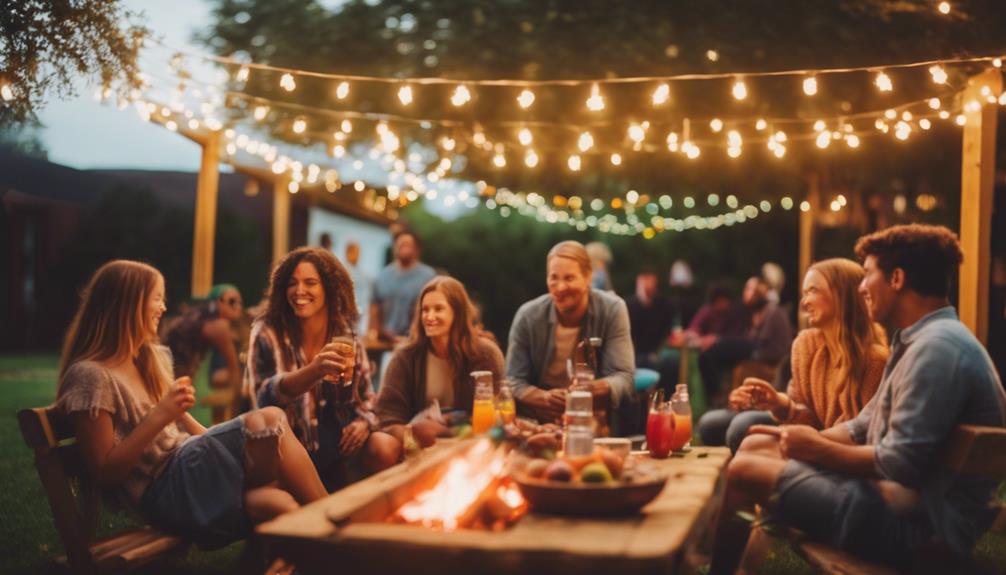
To keep your guests entertained, consider some interactive activities that everyone can enjoy.
Set up yard games, create a DIY cocktail station, or host a tasting party to spark conversation and laughter.
These engaging options will make your late summer gathering memorable for all.
Interactive Yard Games
Engaging your guests with interactive yard games can transform a simple gathering into an unforgettable celebration filled with laughter and friendly competition. Setting up classic yard games like cornhole, giant Jenga, or lawn darts is a good idea to encourage everyone to join in. These games are easy to set up and require minimal skill, making them perfect for all ages.
For a more collaborative atmosphere, consider incorporating team-based activities like tug-of-war or sack races. This not only promotes teamwork but also invites plenty of laughs, ensuring everyone has a great time.
You could even organize a mini Olympics with various games and challenges, allowing guests to earn points for their teams. This friendly competition fosters camaraderie and excitement throughout the event.
Make sure to provide clear instructions and all necessary equipment for each game, so everyone can participate effortlessly. To add an extra layer of motivation, offer small prizes or fun certificates for the winners. These little touches can make your interactive yard games even more memorable and enjoyable for your guests.
Tasting Party Experiences
Interactive yard games can kick off the fun at your late summer gathering, but adding a tasting party experience takes the celebration to a whole new level, inviting guests to savor and explore flavors together. Organizing a tasting party enhances the guest experience by allowing everyone to sample a variety of foods or beverages, sparking social interaction and conversation.
Start by providing small glasses or plates for easy sampling, which makes it simple to try multiple items without feeling overwhelmed. Consider designating a bartender or host to guide guests through a blind tasting experience. This not only helps identify flavors and ingredients but also fosters engagement and discussion among attendees.
Encourage your guests to bring their favorite drinks or dishes to share, creating a diverse tasting menu that allows everyone to contribute to the experience. You can also set up themed tasting stations, like a cheese and wine pairing or a craft beer flight, to provide structure while still allowing for creativity and exploration.
With these elements in place, your tasting party will surely be a memorable highlight of your late summer gathering!
DIY Cocktail Stations
Setting up a DIY cocktail station lets guests craft their own drinks, adding a fun and personalized touch to your late summer party. To create an engaging experience, provide a variety of spirits, mixers, and fresh garnishes like fruits and herbs. This way, everyone can customize their cocktails to match their tastes.
Make it even easier for your guests by offering clear recipe cards featuring popular cocktails. This gives them inspiration and guarantees they can mix their drinks with confidence. Don't forget to include essential tools like shakers, jiggers, and ice buckets at the station to streamline the process and enhance the experience.
Designate a bartender or a knowledgeable friend to assist guests, offering tips and tricks for cocktail mixing. This will encourage everyone to get involved and feel comfortable experimenting with flavors.
Additionally, consider incorporating a non-alcoholic mocktail option at the station. This ensures that all guests, regardless of their preferences, can enjoy the fun of your DIY cocktail stations during the summer party.
With these elements in place, your cocktail station will be a hit, making your gathering memorable and enjoyable for everyone!
Outdoor Setup Tips
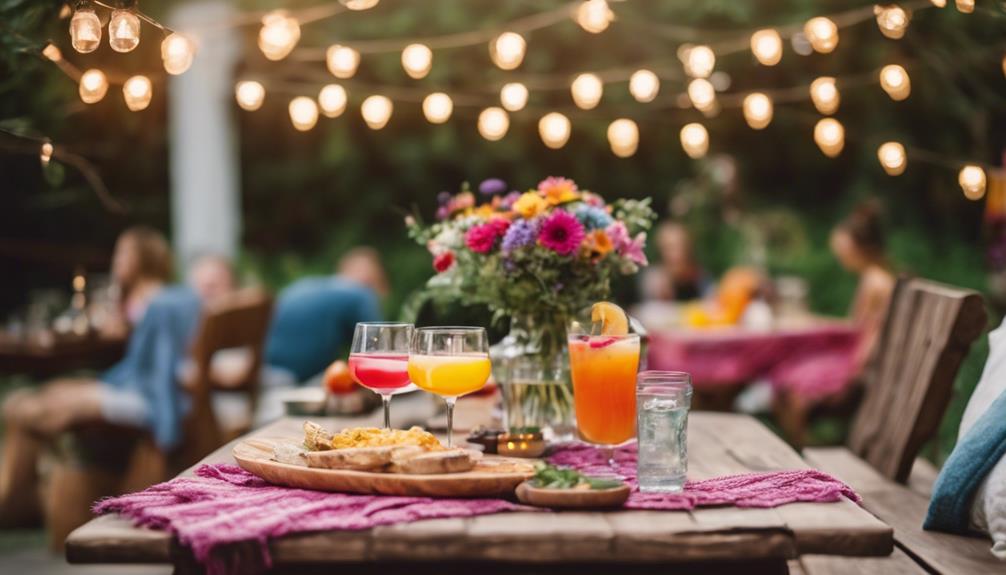
To create a comfortable outdoor space for your late summer party, make sure to include shaded areas and cozy seating that invite guests to relax and mingle.
Use canopies, umbrellas, or natural shade from trees to protect your guests from the sun and keep them comfortable during peak heat. Enhance your setup with outdoor rugs, cushions, and blankets to define seating areas, encouraging conversation and connection.
Consider incorporating ambient lighting, like string lights or lanterns, to cultivate a warm and inviting mood as the sun sets. This makes the space feel more intimate and welcoming.
Additionally, set up a comfortable retreat area with fans or misters to provide relief from the heat, ensuring your guests can cool down and stay hydrated throughout the event.
As the evening approaches, arranging a fire pit or outdoor heater creates a cozy space for guests to gather, share stories, and enjoy s'mores or warm drinks.
These outdoor setup tips will help you create a delightful atmosphere that keeps your guests comfortable and engaged, making your late summer party truly memorable.
Final Touches for Excellence

Enhancing your late summer party with thoughtful final touches can elevate the overall experience and create lasting memories for your guests.
Start by setting up self-serve snack stations. This encourages mingling and allows everyone to customize their bites, making your gathering feel more interactive and relaxed.
For dinner, make certain there's a visually appealing dessert display, perhaps an XXL dessert that will leave a lasting impression as the final course of the meal.
Utilize seasonal flowers as understated centerpieces. They enhance your table's aesthetic without overwhelming the dining experience.
It's all about those final touches for excellence that tie everything together.
Ascertain that food is served at room temperature; this not only simplifies serving but also allows your dishes to retain their flavor and texture, making each bite enjoyable.
Guest List Management Strategies
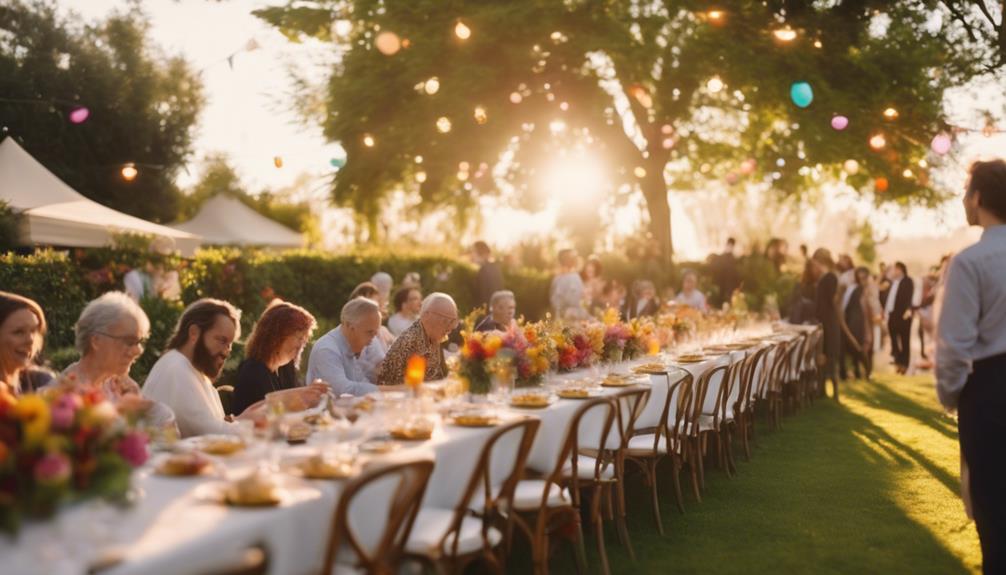
When managing your guest list, focus on inviting familiar faces to create a relaxed vibe.
Balancing dynamics among your attendees can enhance interactions and make your party more enjoyable.
Plus, using efficient RSVP collection methods helps you keep track of who's coming and guarantees you're prepared for the right number of guests.
Inviting Familiar Faces
Crafting a guest list of 15-18 familiar faces can create a warm atmosphere that encourages meaningful interactions and connections. When you focus on inviting familiar faces, you help ease social dynamics, making it easier for everyone to engage.
Make sure each guest knows at least one other attendee to minimize awkwardness and foster connections among them.
Send out your invitations well in advance, whether you choose traditional methods or digital platforms like Paperless Post. This not only builds anticipation but also helps you gather RSVPs effectively.
You might want to take into account a potluck format, allowing guests to bring their favorite dishes. This enhances variety and promotes a sense of community while keeping costs manageable.
As you compile your list, think about inviting individuals who share common interests or backgrounds. This strategy contributes to a lively and harmonious environment, making the experience more enjoyable for everyone involved.
Balancing Guest Dynamics
Balancing guest dynamics is essential for creating an enjoyable atmosphere where everyone feels comfortable and engaged. To achieve this, aim for a guest list of 15-18 people. This size strikes a balance between liveliness and intimacy, allowing for meaningful interactions.
When you invite guests, encourage them to know at least one other attendee. This reduces social awkwardness and helps facilitate smoother conversations. You can accomplish this by selecting guests based on shared interests or connections, guaranteeing they've common ground to discuss.
Consider using digital platforms like Paperless Post or traditional invitations to effectively communicate event details. This not only keeps everyone informed but also helps you gather RSVPs for better planning.
A potluck format is another excellent way to balance dynamics. By inviting guests to bring their favorite dishes, you foster a sense of community while managing costs and food variety. This setup encourages guests to share stories about their dishes, further enhancing engagement.
Ultimately, thoughtful guest list management guarantees a memorable late summer party where everyone feels included and connected.
RSVP Collection Methods
Effectively managing your guest list hinges on implementing efficient RSVP collection methods that keep your planning on track. Utilizing online platforms like Eventbrite or Paperless Post can streamline this process, allowing you to track responses in real time. Make certain to include a clear RSVP method in your invitation, whether it's a reply email or a link, to minimize confusion.
Set a deadline for RSVPs to guarantee you receive timely responses, which helps you finalize your planning well in advance. To encourage participation, consider offering incentives—like a special drink served in a wine glass or a unique appetizer for those who respond early. This not only boosts excitement but also fosters a sense of community among your guests.
As the RSVP deadline approaches, send a friendly reminder to those who haven't responded yet. This gentle nudge will help you secure an accurate headcount for food and seating arrangements.
Invitations and RSVP Process
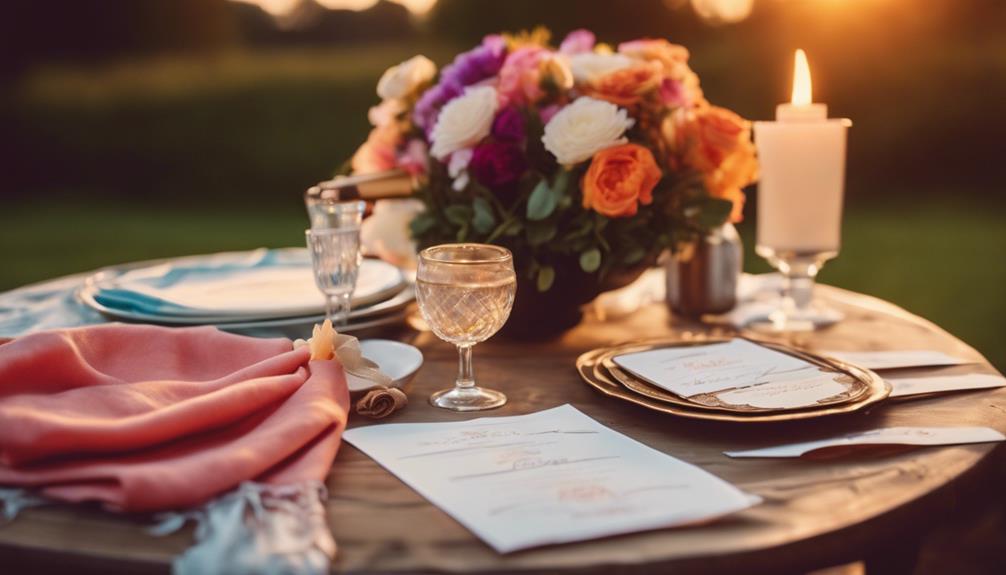
To guarantee your late summer party is a hit, send out invitations at least three weeks in advance so guests have enough time to clear their schedules. This way, you make certain that everyone has ample time to respond and plan accordingly.
Utilize online platforms like Paperless Post or Evite to create customized digital invitations that match your party theme. These platforms also make it easy to track RSVPs.
In your invitations, clearly state the date, time, and location, along with any specific instructions such as potluck contributions or a dress code. This helps avoid confusion and makes sure everyone knows what to expect. Additionally, include an RSVP deadline, ideally one week before the event. This allows you to finalize your preparations and manage the guest list effectively.
A few days before the party, consider sending a friendly reminder to guests who haven't yet responded. This not only confirms attendance but also generates excitement for the gathering.
Bar Setup and Drink Ideas
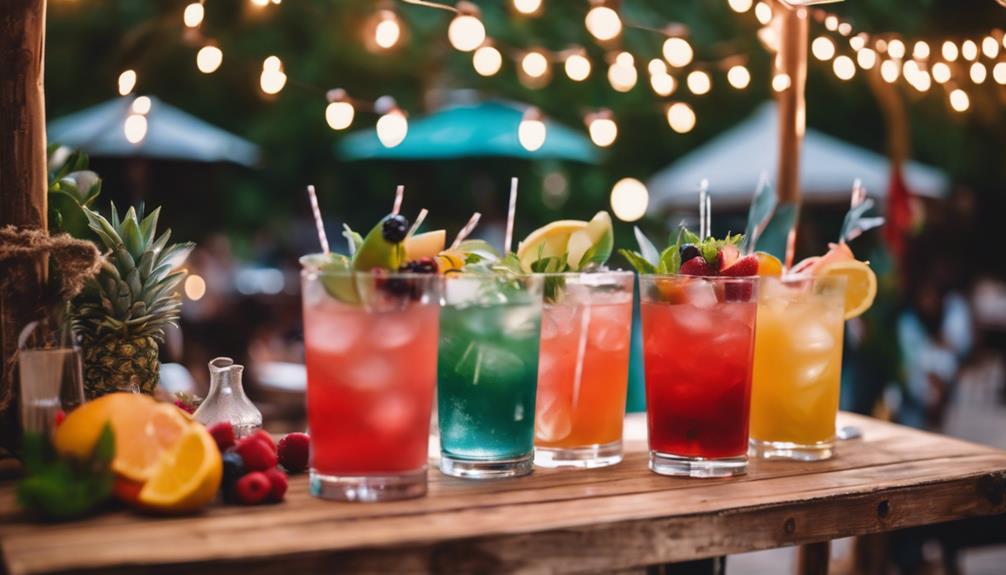
Create an inviting bar setup that features shaded areas, curated glassware, and essential tools to enhance your late summer party experience. A well-organized bar not only serves drinks but also becomes a focal point for mingling.
Consider these key elements for your bar setup:
- Pre-batched cocktails: Save time by preparing popular cocktails or revitalizing mocktails in large dispensers or pitchers. This way, guests can help themselves without any hassle.
- Garnish station: Offer an array of garnishes like fresh herbs, citrus slices, and flavored syrups. This allows guests to customize their drinks, adding a personal touch.
Additionally, make sure you have plenty of ice and a cooler stocked with bottled drinks to keep everything chilled and easily accessible.
With a thoughtful bar setup, you'll create a relaxed and enjoyable atmosphere that keeps your guests revitalized and engaged throughout the party!
Food Presentation Techniques
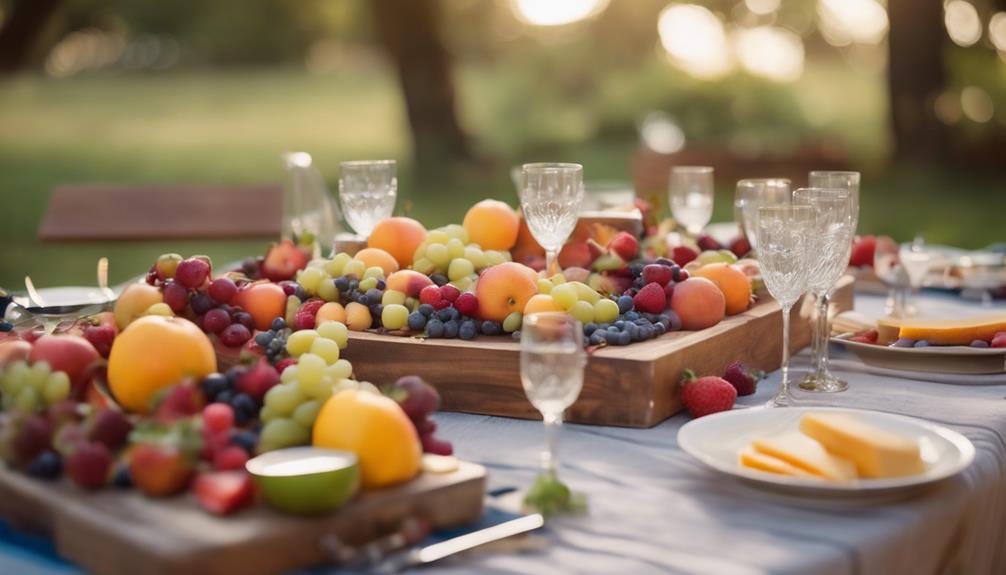
Elevating your food presentation can transform a simple buffet into a visually stunning centerpiece that captivates your guests. Start by utilizing varying heights and levels on your buffet table. Use cake stands or stacked boxes to create visual interest that draws the eye. Serving food on ice, especially seafood or chilled salads, not only keeps them fresh but adds a touch of elegance.
Incorporate contrasting textures and colors in your arrangement. Pair creamy dips with crunchy vegetables to enhance both visual appeal and flavor balance. Opt for rustic ceramics or white tableware to let your dishes shine without distraction. Simple serveware allows the vibrant colors of your food to stand out.
To tie everything together, garnish your dishes with fresh herbs or edible flowers. This not only elevates the look but also adds aromatic qualities to the dining experience. When you master these food presentation techniques, you'll create a delightful atmosphere that encourages your guests to indulge in your culinary creations.
Maintaining a Relaxed Vibe
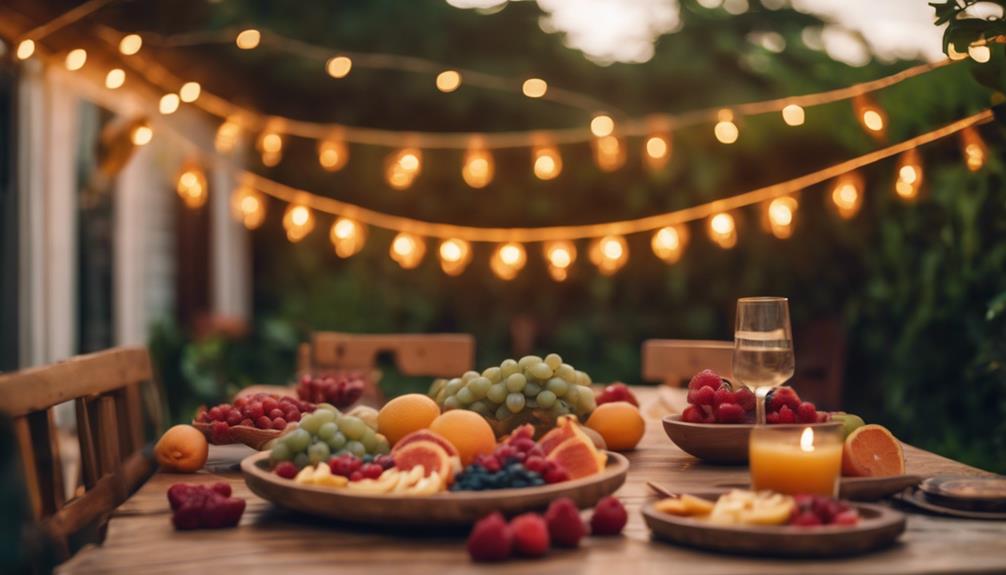
A beautifully presented spread sets the stage, but maintaining a relaxed vibe is key to keeping your guests comfortable and engaged throughout the party. Start by greeting your guests enthusiastically and offering drinks and light snacks right away. This sets a welcoming tone that encourages mingling.
Consider these tips to enhance the relaxed atmosphere:
- Self-Serve Snack Stations: Set up portable bowls filled with snacks to let guests graze at their leisure. This informal setup encourages interaction without the pressure of a formal meal.
- Casual Seating: Create cozy spots with cushions and blankets. Comfortable seating arrangements make it easier for guests to gather and engage in conversations.
Embrace a go-with-the-flow attitude throughout the party. Be flexible with your plans and adapt to the gathering's vibe, ensuring everyone feels comfortable and engaged.
With these strategies, you'll cultivate a relaxed environment that keeps your guests returning for more!
Frequently Asked Questions
How Do You Host an Interesting Party?
To host an interesting party, create a diverse menu, set up engaging activities, curate a lively playlist, arrange comfortable seating, and warmly welcome guests with refreshments to encourage mingling and connection right from the start.
How Do You Throw an End of Summer Party?
To throw an end of summer party, plan a simple menu with chilled dishes, create a cozy outdoor space, engage guests with fun activities, and offer revitalizing drinks to keep everyone cool and entertained.
How Do You Throw a Summer House Party?
You'd think throwing a summer house party is easy, but it's not! Start by inviting familiar faces, planning a make-ahead menu, and setting up engaging activities to keep everyone entertained and relaxed.
Conclusion
As you wrap up your late summer party preparations, remember: 'The best memories are made around the table.'
With thoughtful menu planning, a warm atmosphere, and engaging activities, you're set for a fantastic gathering.
Keep things relaxed and enjoy each moment with your guests.
By adding those final touches and a well-stocked bar, you'll create an unforgettable experience that everyone will cherish.
So, kick back, enjoy the company, and let the good times roll!
